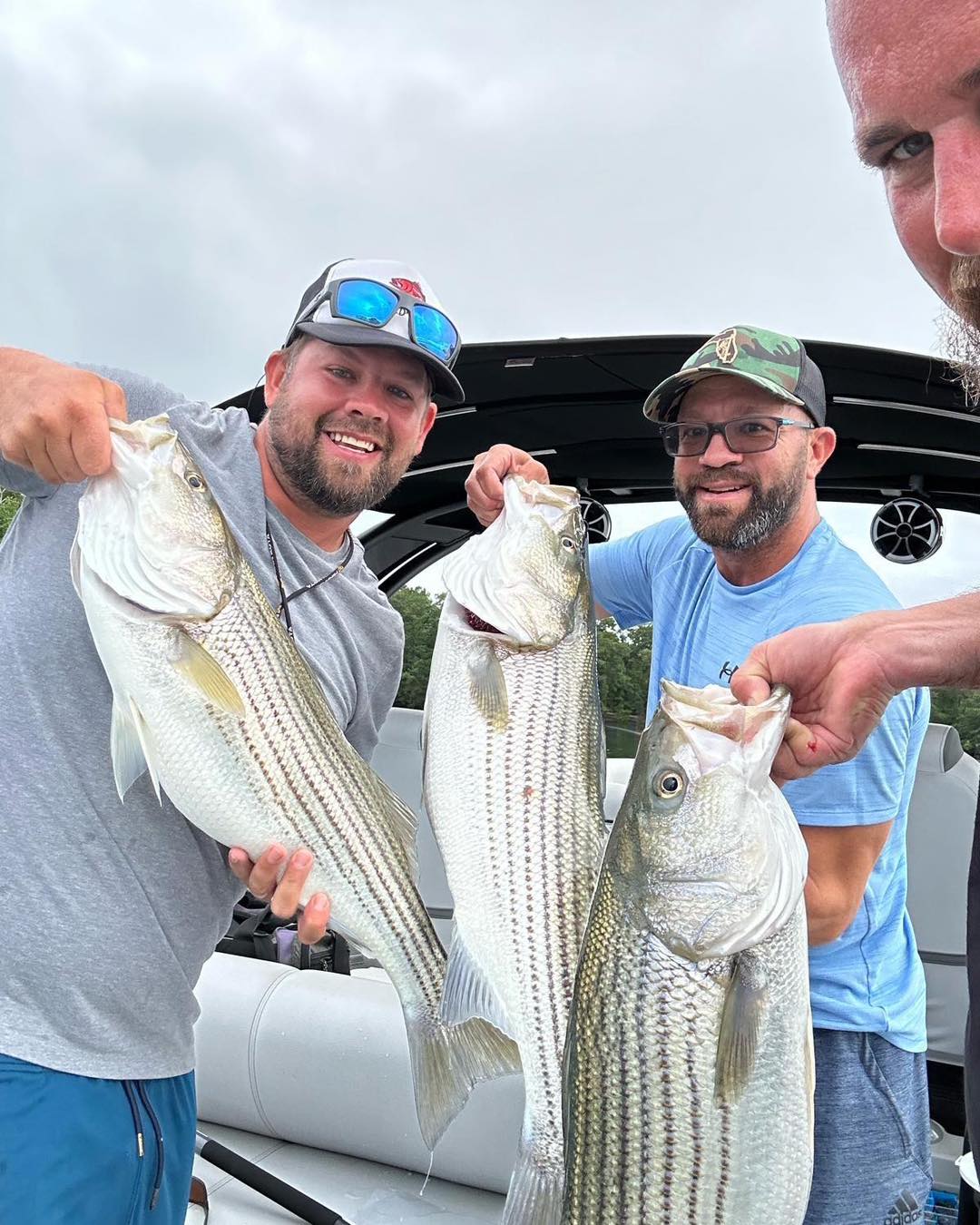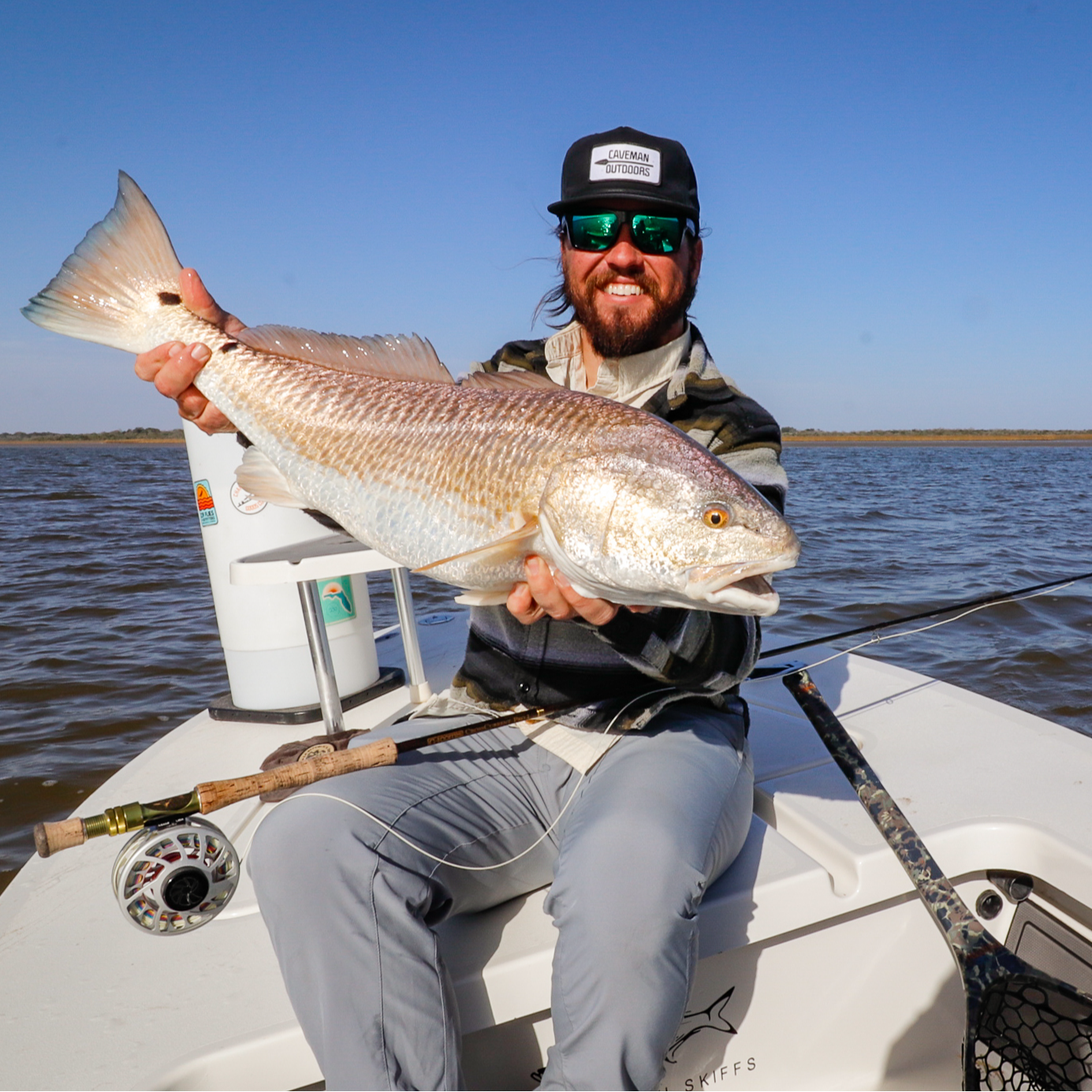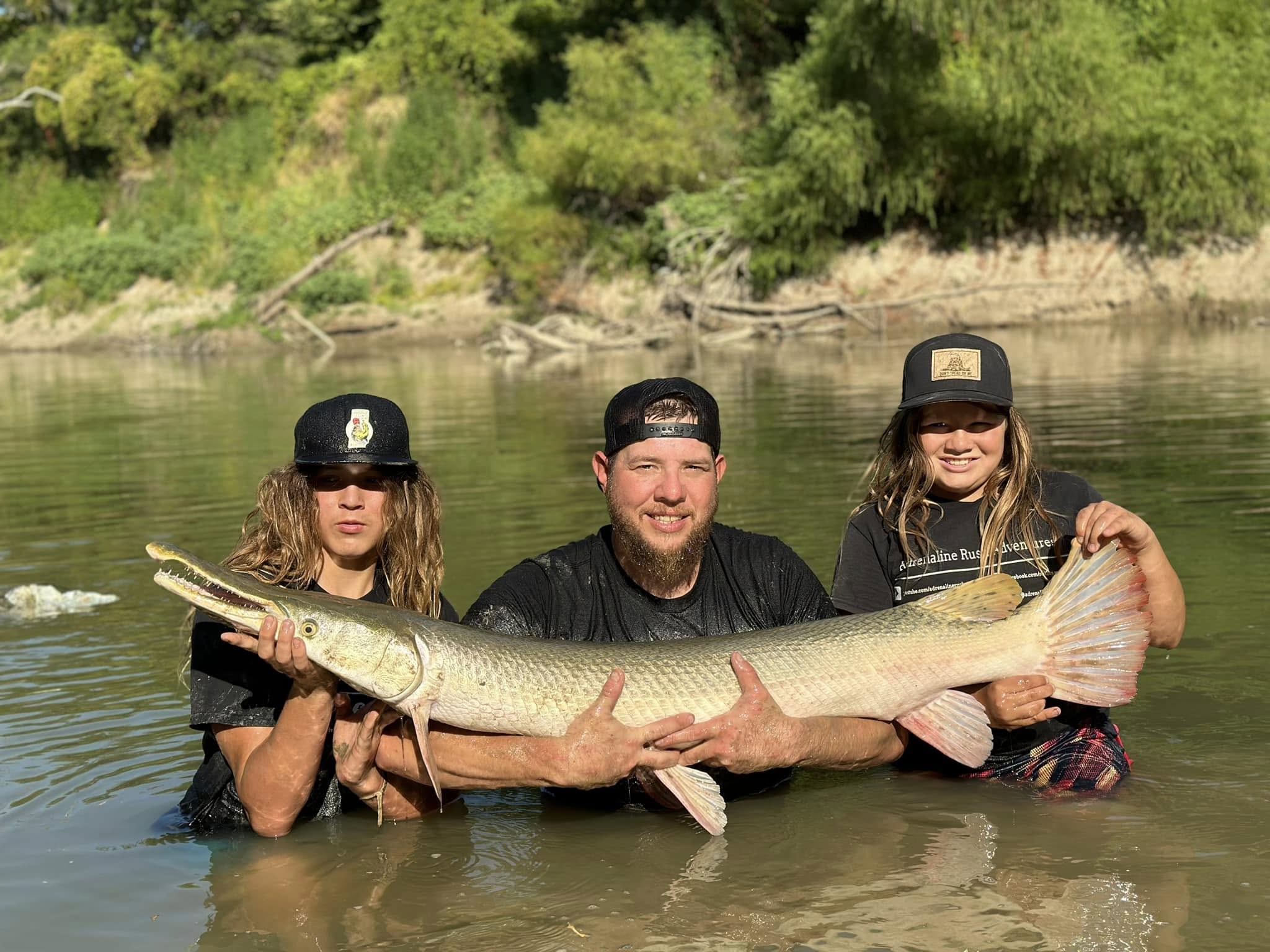4-6 Hour Trip – Bowfishing
Inshore, Flats Fishing in Port O'Connor
Bowfishing In Port O' Connor Texas
Inshore, Flats Fishing in Rockport
Bowfishing In Rockport Texas
Full Day On Lake Lanier
River, Lake Fishing in Cumming
Lake Lanier Mixed Bag
Inshore, Flats Fishing in Aransas Pass
Fly-fishing/Sight-fishing
Lake Lanier Fishing Trip
Alligator Gar Fishing
Falcon Lake Bass And Cats
River, Lake Fishing in Houston
Monster Gar On Rod And Reel
We started Captain Experiences to make it easy to book fishing and hunting guides around the world. With over 2,000 Damn Good Guides, our platform makes finding and booking a trip seamless. Head here to check out our trips.
The summertime means alligator gar are ready to come out. In Texas, alligator gar are a unique species with a long history to match their notoriously large bodies.
As a declining species, you definitely want to look towards Texas to catch or spot an alligator gar, as it's home to one of the largest alligator gar populations there is. Before you book your charter, it's important to know exactly how to catch, spot, and think about an alligator gar, so keep reading to do just that!
What is Captain Experiences?
We’re on a mission to Unlock the Outdoors for everyone. With thousands of Damn Good Guides across the US and beyond, our platform makes booking quality, vetted guides quick and easy.
Check out our Texas alligator gar tripsWhat is an Alligator Gar?
When you spot an alligator gar, also called a gator gar, you may be shocked to see such a dinosaur-like creature swimming with crappie and bass. Alligator gar are huge fish, with quite a distinct appearance. Members of this species have long, slender, and cylindrical/torpedo-shaped bodies. Their uniqueness is also dubbed by their interlocking and diamond-shaped ganoid scales.
Alligator gar are the largest growing animal within their species, growing up to 8ft long and weighing up to 300lbs. That’s a lot of gar!
Younger alligator gar have two rows of teeth on both sides of their upper jaw which sets them apart from other gar species. They can also be distinguished by their dorsal and anal fins on the back of their body, opposing one another.

Where Can You Find an Alligator Gar in Texas?
While alligator gar populations have diminished in most states, alligator gar in Texas remain a prominent animal when it comes to Texas sport fishing] (although there are regulations as mentioned below).
If you are looking for an alligator fishing charter in Texas, head straight to the rivers, reservoirs, and coastal bays. Booking an alligator gar trip in areas of Texas like Galveston, Corpus Christi, Matagorda, or the Laguna Madre means your fishing charter will be within the inter-coastal waterway system, where alligator gars often love to reside.
Alligator gar in the north of Texas can be found in the Red River, as well as Lake Texoma, the Upper Trinity, and the Sulfur River. In southwest Texas, alligator gar reside in the middle and lower Rio Grande, and in lakes like Falcon Lake and Amistad Lake.
In East Texas, alligator gar are found in Cypress Creek, the Sabine, Neches, Angelina, and Trinity Rivers. Alligator gar in East Texas can also be found in reservoirs such as Caddo Lake, Lake Sam Rayburn, Toledo Bend Reservoir, and Lake Livingston.
Along the coast of Texas, alligator gar almost always occupy every river system that drains into the Gulf of Mexico: the middle and lower Brazos River, Nueces River, Frio River, San Antonio River, and Guadalupe river.
Trinity River of Texas is widely regarded as the world’s best alligator gar fishing location, putting the biggest and best of the gar species right in the middle of Texas. But as previously mentioned, Texas has plenty of awesome alligator gar spots around. If you’re looking to try to catch gar, be sure to check out our Texas alligator gar fishing charters to book your trip with one of our local and professional alligator gar fishing guides.
When is the Best Time to Go Alligator Gar Fishing?
For such a unique fish, you definitely want to know when is best to search for an alligator gar: the answer to that question would be…now! The best time to go alligator gar fishing is during the hottest months of the summer in the end of June, July, and August.
When water temperatures rise from 70°F to 90°F, gar feed more actively and alligator gar surface activity increases. In general though, if you are interested in any alligator gar action, their activity often begins at the end of May and continues through September, October, and sometimes into the start of November.

How to Catch a Gar: Techniques and Tricks to Use for Alligator Gar Fishing:
There are many techniques to use when you book a fishing charter to catch an alligator gar. Depending on the area, experience, skill, and gear, your guide will work you through the best techniques to use.
Alligator Gar Fly Fishing
To fly fish for alligator gar, anglers cast frayed rope-like streamer flies to surfacing gars. When an alligator gar strikes, the threads of the fly tangle in the gar’s teeth and gar can be caught without even needing a hook!
Topwater Fishing
Using a topwater lure is another great way to effectively catch alligator gar. While this technique is useful, it also requires patience. Just cast a baitfish imitation plug in front of the gar when you spot one on the surface of the water. After you cast, the alligator gar will click its fins and shadow the bait.
The trick is to keep the lure relatively still since the alligator gar will be moving towards the bait very slowly. Once the gar is close to the topwater lure, twitch the lure to keep the gar interested and you'll be in for a fight!
Fishing for Gar with Live Bait
A great way to attract alligator gar is to use live bait. Using a bobber to set live bait like common carp and live shiners on a hook. Fasten the hook to a steel leader and strong braided line, and suspend the baitfish in the water column with or without a weight.
It’s important to know that they love a good-sized live bait. Examples of some bait that gars love include baitfish like shiners, shad, or suckers, as well as carp, buffalo, and large perch.
Bowfishing for Alligator Gar
Bowfishing for gar is regarded as a more intense method, but it's nonetheless entertaining to learn about. Bowfishing literally uses a bow and arrow. Once an alligator gar is shot with an arrow it cannot be released.
Spotting a Gar Giveaway
If you’re out on the boat looking for an alligator gar, keep an eye out for schooling baitfish (such as shad, shiners, or freshwater mullet). When baitfish break the water like they’re being chased by a predator, this indicates that alligator gar are likely nearby.
Reeling in an Alligator Gar
For the best chance at catching an alligator gar, cast your line into the deeper parts of the channel. To allow the alligator gar to take its bait and move with it, leave your spool open and for a few clicks, let the gar run. It's important to allow an alligator gar enough time to swallow the bait and hook before reeling since alligator gar usually travel a substantial distance before they eat the bait. This is because, unlike most, the alligator gar has a bony upper jaw, meaning they are less prone to being firmly hooked.
To know you’ve actually got an alligator gar hooked, you may notice the fish “torpedo” across the water or dive deeper into the water. If this happens, lower your rod towards the alligator gar, and after the line pulls tight wait around 10 seconds.
Where Do Alligator Gar Come From?
The history of the alligator gar is a long one, much longer than even a full day’s worth of gar fishing! This history also distinguishes them as a standout fish for Texans.
Alligator gar are an important part of Texas fisheries. The fossils of ancient alligator gar date back to 215 million years ago, found in Permian era deposits.
The alligator gar has been around since the dinosaurs were on earth. Today, although dinosaurs are unfortunately gone, alligator gar can sometimes reach dinosaur proportions. The largest alligator gar can grow up to 10 feet long and over 300 pounds. On top of their size, they have double rows of menacing, alligator-like teeth, with a long and broad mouth.

Southern Native Americans in the Texas area and people from the Caribbean used to use the ganoid scales of gars for arrowheads, breastplates, and shielding to cover plows. Alligator gar skin was also used to make items such as bags and purses.
Then everyone’s opinion on gar took a turn- no longer used to make objects, alligator gar were called the “trash fish,” or a “nuisance species.” Of course, this idea was led by state authorities whose goal was to target the gar for elimination to protect the gamefish populations. They have also gained their “useless” title because most people believed they were dangerous to humans.
Through the years, more awareness and knowledge about alligator gars spread. One of the first groups to help restore alligator gar and begin restoration practices was the Missouri Department of Conservation. The MDC teamed up with states like Tennessee, Arkansas, Kentucky, Illinois, Alabama, Mississippi, Texas, Oklahoma, and Louisiana to increase awareness for alligator gar conservation.
Overall, alligator gar are one of the oldest and largest Texas freshwater species. This, alongside their history, makes them such a special bucket list catch for any Texan, and is a sure reason to book an alligator gar trip with one of our local and professional guides to try to hook one of your own!
How to Spot an Alligator Gar
Everyone, especially Texans, loves to boast that they’ve spotted a gar- who wouldn't want to? But actually, alligator gar are one of the most incorrectly identified Texas fish, especially because there are really four different species of gar in Texas.
These species are spotted gar, shortnose gar, longnose gar, and alligator gar. So even though Texas has one of the highest alligator gar populations around, here’s how to know that you’ve actually spotted an alligator gar.
What distinguishes an alligator gar from the other gar species is mainly their large size (the largest out of all of the gar species), heavy, torpedo-shaped bodies, double row of teeth on their upper jaws (whereas the other species have one row), and short, broad snouts.
You have spotted a longnose gar if the snout is more than twice the length of its head, and is thin, no more than a couple of inches wide.
You have spotted a Florida or a spotted gar if you notice a shorter snout with brown spots.
Because the longnose gar are common throughout Texas and are larger in size, this type of gar is most commonly confused for an alligator gar. But although the fish may be the same length, an alligator gar will be wider with a short and wide snout (which will look like an alligator if you see this from an above angle).
Are Alligator Gars Dangerous?
With a name that quite clearly includes the word “alligator”, it’s no surprise so many assume that alligator gars are dangerous, or may try to bite a human. Not to mention, their size and number of teeth don’t help.
But despite their appearance, the tales (no pun intended!) of alligator gar attacking people have been mostly just dramatized for television.

In reality, these menacing-looking creatures are actually quite slow and docile. Because of how they feed, adult alligator gar often take a while to swallow the bait, or at least hesitate before doing so. This means, if the alligator gar senses one thing may be off or risky, they will back away from the bait.
Now, you're probably still curious about that double row of chompers. The truth is, the teeth of alligator gar are meant to subdue and take on their prey, rather than rip them up into small bites as a shark would. Basically, this means alligator gar don’t eat what they can’t swallow.
Of course, that doesn’t mean that if an angler is careless and tries manhandling this creature with bony, sharp scales, that they won’t be cut or bruised in the process.
Another time to be careful with an alligator gar is in the process of landing, unhooking, or releasing one. Unlike a bass or crappie, dealing with an alligator gar requires a plan. An alligator gar should be landed with a large net, cradle, or a rope lasso.
An alligator gar should also be kept on their stomach either on the boat deck or the ground. Stay clear of this creature’s tail and definitely keep your hands away from the alligator gar’s mouth.

Alligator Gar Double Row of Teeth. Source: [MySA](https://www.mysanantonio.com/sports/outdoors/article/Huge-Alligator-Gar-Caught-in-Trinity-River-13004587.php)
Lastly, after an alligator gar is removed from your boat deck, make sure to wipe it down to avoid a big fall- alligator gar leave behind a slimy coat!
Texas Alligator Gar Record
In 2001, Marty McClellan set the Texas state alligator gar bowfishing record with a 290 lb (130 kg) alligator gar from the Trinity River. The all-tackle alligator gar record was achieved by T.C. Pierce, Jr, who caught a 302 lb (137 kg) alligator gar on a trotline.
Alligator Gar Regulations in Texas
Almost as important as actually catching an alligator gar, is knowing Texas regulations on when and where to actually catch them.
One of the most important regulations to note about alligator gar is mandated reporting. Other than Falcon International Reservoir, any alligator gar that is harvested out of Texas public waters must be reported to the department within 24 hours. This can be done using a mobile app or online.

Texas Alligator Gar Bag Limits
- For alligator gar, daily bag limit is 1 fish of any size.
- No bag limits on other species of gar.
- Certain areas may be temporarily closed to alligator gar fishing when optimum spawning conditions occur.
Temporary Closures
TPWD Executive Directors may temporarily close down or prohibit alligator gar fishing when there are prime spawning conditions for alligator gar. These conditions may include water temperatures between 68 to 82°F or moderate flood levels, all defined by the U.S. Geological Survey gauges. These temporary closures can be read about on the web page or social media.
Falcon Lake Alligator Gar Fishing Exceptions
The daily bag limit is 5 fish for alligator gar while the possession limit is 10. There is no mandatory harvest reporting for alligator gar.
Trinity River Alligator Gar Exceptions:
Retained alligator gar must be less than 48 inches and only 1 alligator gar per person is the daily bag limit. Between a half-hour after sunset and a half-hour before sunrise, no one can trap an alligator gar using lawful archery equipment or crossbow unless they possess a harvest authorization.
Opportunities to Draw for Harvest on the Trinity River
If you’re an angler looking to get authorized to harvest an alligator gar over 48 inches, you can enter a drawing! Selected anglers will be permitted to harvest an alligator gar over 48 inches in length from the Trinity River.
This section of the Trinity River covers the I-30 bridge in Dallas downstream to the I-10 bridge in Chambers County, including Lake Livingston and the East Fork of the Trinity River upstream to the dam at Lake Ray Hubbard.
Now that you know so much more about alligator gar, act on it! It's summer and the perfect time to book an alligator gar fishing trip with one of our professional and local alligator gar guides.
Samantha Baron
Updated on June 22, 2023

November 15, 2023

November 7, 2023

January 19, 2021

June 3, 2021

October 26, 2020
Related Articles
November 23, 2021
January 19, 2023
Featured Locations
- Fishing Charters Near Me
- Austin Fishing Guides
- Biloxi Fishing Charters
- Bradenton Fishing Charters
- Cabo San Lucas Fishing Charters
- Cancun Fishing Charters
- Cape Coral Fishing Charters
- Charleston Fishing Charters
- Clearwater Fishing Charters
- Corpus Christi Fishing Charters
- Crystal River Fishing Charters
- Dauphin Island Fishing Charters
- Daytona Beach Fishing Charters
- Destin Fishing Charters
- Fort Lauderdale Fishing Charters
- Fort Myers Fishing Charters
- Fort Walton Beach Fishing Charters
- Galveston Fishing Charters
- Gulf Shores Fishing Charters
- Hatteras Fishing Charters
- Hilton Head Fishing Charters
- Islamorada Fishing Charters
- Jacksonville Fishing Charters
- Jupiter Fishing Charters
- Key Largo Fishing Charters
- Key West Fishing Charters
- Kona Fishing Charters
- Lakeside Marblehead Fishing Charters
- Marathon Fishing Charters
- Marco Island Fishing Charters
- Miami Fishing Charters
- Montauk Fishing Charters
- Morehead City Fishing Charters
- Naples Fishing Charters
- New Orleans Fishing Charters
- New Smyrna Beach Fishing Charters
- Ocean City Fishing Charters
- Orange Beach Fishing Charters
- Panama City Beach Fishing Charters
- Pensacola Fishing Charters
- Pompano Beach Fishing Charters
- Port Aransas Fishing Charters
- Port Orange Fishing Charters
- Rockport Fishing Charters
- San Diego Fishing Charters
- San Juan Fishing Charters
- Sarasota Fishing Charters
- South Padre Island Fishing Charters
- St. Augustine Fishing Charters
- St. Petersburg Fishing Charters
- Tampa Fishing Charters
- Tarpon Springs Fishing Charters
- Venice Fishing Charters
- Virginia Beach Fishing Charters
- West Palm Beach Fishing Charters
- Wilmington Fishing Charters
- Wrightsville Beach Fishing Charters

































